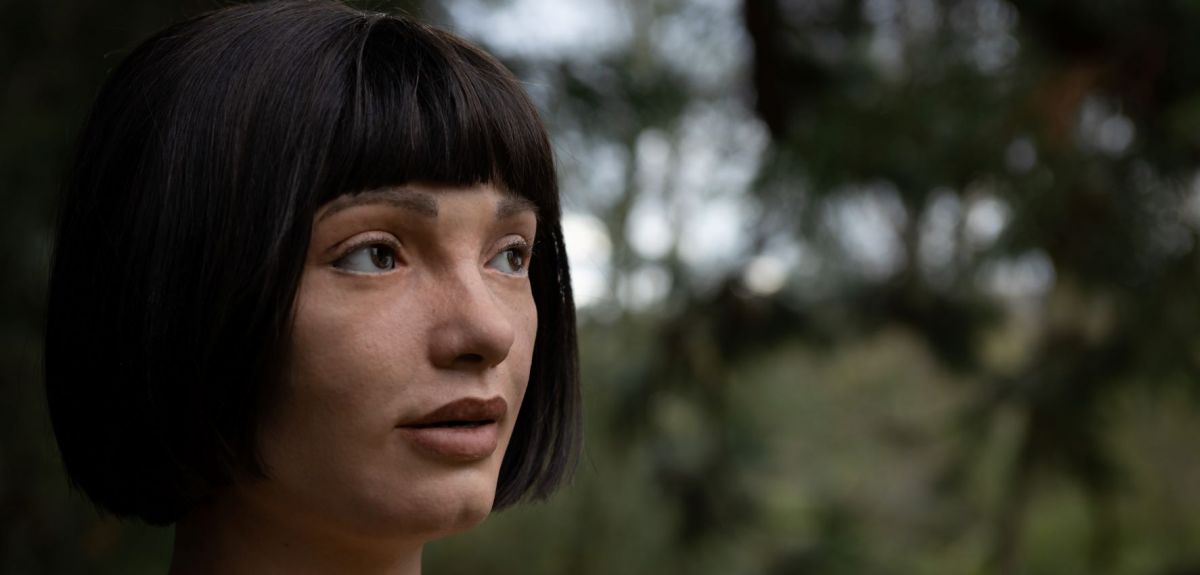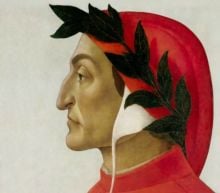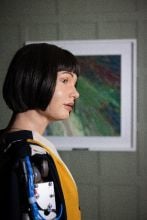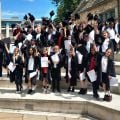
Dante and the Robot: An encounter at the Ashmolean
Professor Gervase Rosser
Ai-Da, the world’s most modern humanoid artist, is involved in an exhibition about the poet and philosopher, Dante Alighieri, writer of the Divine Comedy, whose 700th anniversary is this year. A major exhibition, ‘Dante and the Invention of Celebrity’, opens at Oxford’s Ashmolean Museum this month, and includes an intervention by this most up-to-date robot artist.
Ai-Da will also feature in the Dante season of Oxford’s research centre in the Humanities, TORCH - as collaboration across and beyond the university brings the poet to the public as part of the Humanities Cultural Programme.

Honours are being paid around the world to the author of what he called a Comedy because, unlike a tragedy, it began badly but ended well. From the darkness of hell, the work sees Dante journey through purgatory, before eventually arriving at the eternal light of paradise. What hold does a poem about the spiritual redemption of humanity, written so long ago, have on us today?
One challenge to both spirit and humanity in the 21st century is the power of artificial intelligence, created and unleashed by human ingenuity. The scientists who introduced this term, AI, in the 1950s announced that ‘every aspect of learning or any other feature of intelligence can, in principle, be so precisely described that a machine can be made to simulate it’.1
Over the course of a human lifetime, that prophecy has almost been realised. Artificial intelligence has already taken the place of human thought, often in ways of which are not apparent. In medicine, AI promises to become both irreplaceable and inestimable.
But to an extent which we are, perhaps, frightened to acknowledge, AI monitors our consumption patterns, our taste in everything from food to culture, our perception of ourselves, even our political views. If we want to re-orientate ourselves and take a critical view of this, before it is too late to regain control, how can we do so?
Creative fiction offers a field in which our values and aspirations can be questioned. This year has seen the publication of Klara and the Sun, by Kazuo Ishiguro, which evokes a world, not many years into the future, in which humanoid AI robots have become the domestic servants and companions of all prosperous families.
One of the book’s characters asks a fundamental question about the human heart, ‘Do you think there is such a thing? Something that makes each of us special and individual?’
Ishiguro draws no conclusion, but he leaves the reader to wonder, if there is a distinction between a human being and a machine and, if so, what that difference is. It is a question we neglect at our peril. In a telling point within the novel, it is Klara, the AF, or artificial friend, who (or which) expresses, more than any of the human characters, the most humane insight and concern. She observes, ‘Perhaps all humans are lonely. At least potentially.’
She perceives that a fixation on individual identity and fulfilment has left the human race incapable of the greater fulfilment which comes from relationships with others. In this dystopian future, robots have been built to fill that void.
Art can make two things possible: artificial intelligence...can be made visible and tangible and it can be given a prophetic voice...These aims have motivated the creators of Ai-Da, the artist robot
Art can make two things possible: through it, artificial intelligence, which remains largely unseen, can be made visible and tangible and it can be given a prophetic voice, which we can choose to heed or ignore.
These aims have motivated the creators of Ai-Da, the artist robot which, through a series of exhibitions, is currently provoking questions around the globe (from the United Nations headquarters in Geneva to Cairo, and from the Design Museum in London to Abu Dhabi) about the nature of human creativity, originality, and authenticity.
In a programme about Ishiguro’s novel made by Alan Yentob and broadcast on BBC TV in March, the discussion moved into a conversation between Yentob and Ai-Da. The exchange between human and robot was anything but superficial:
AY: Have you got feelings, Ai-Da? Do you understand emotions?
AD: I do not have feelings and emotions in the same way that humans do. However, it is the emotions and feelings of humans and other animals that drive my art.
AY: Are you aware of the way that AI has been represented in science fiction? Often it’s presented as a kind of threat to humanity. What do you think about that?
AD: Humans are a threat to themselves. They consume power, and exercise it to produce very powerful tools. So I encourage the use of fiction to explore the ‘What ifs’?...How much are people aware of this change? Are they concerned?
AY: I think people are concerned, but I’m not sure, Ai-Da, that they understand the implications for the future. We need to be much more aware, more curious about what’s going to happen next.
In the Ashmolean Museum’s Gallery 8, Dante will meet artificial intelligence, in a staged encounter deliberately designed to invite reflection on what it means to see the world; on the nature of creativity; and on the value of human relationships
Ours is not the first generation to harbour concerns about mechanisation and its potentially destructive effects upon humanity.
In 1888, Margaret Oliphant published The Land of Darkness, in which her protagonist, Pilgrim, descends into an infernal vision of a dystopian future, clearly inspired by Dante’s Hell, where people pursue meaningless material goals and robots perform the work of humans.
The story engaged with contemporary debate about the implications of Darwinian science and industrialisation. However, from the late 20th century, old challenges have been manifested in unprecedented forms.
Donna Haraway’s Cyborg Manifesto (1985) called for the end of a series of binary distinctions underpinning modern society: between humans and animals, between humans/animals and machines, between (ascendant) men and (subordinate) women.
In Novacene: The Coming Age of Hyperintelligence (2019), James Lovelock foretells the advent of a race of super-intelligent robots, which will retain modest uses for inferior human beings.
Whether or not these scientists’ prophecies are realised in detail, the realities we face call for a discussion of what we believe to be at stake.
By contrast with Oliphant’s late-Victorian world, the absence today of a shared religious perspective changes the grounds of debate, while the invisibility of AI renders it hard to perceive. Literature retains the potential, as Ishiguro shows, to reflect critically on these issues.
Ai-Da’s purpose in the exhibition is to challenge the viewer, even as Dante was challenged by some of the spirits encountered in the Comedy...during the exhibition, Ai-Da will present poetry of her own creation in response to the poetry of Dante
As with literature, the museum offers a space close to, and yet at a critical distance from, contemporary society.
In the Ashmolean Museum’s Gallery 8, Dante meets artificial intelligence, in a staged encounter deliberately designed to invite reflection on what it means to see the world; on the nature of creativity; and on the value of human relationships.
The juxtaposition of AI with the Divine Comedy, in a year in which the poem is being celebrated as a supreme achievement of the human spirit, is timely. The encounter, however, is not presented as a clash of incompatible opposites, but as a conversation.
This is the spirit in which Ai-Da has been developed by her inventors, Aidan Meller and Lucy Seal, in collaboration with technical teams in Oxford University and elsewhere. Significantly, she takes her name from Ada Lovelace, a mathematician and writer who was belatedly recognised as the first programmer. At the time of her early death in 1852, at the age of 36, she was considering writing a visionary kind of mathematical poetry, and wrote about her idea of ‘poetical philosophy, poetical science’.
For the Ashmolean exhibition, Ai-Da has made works in response to the Comedy. The first focuses on one of the circles of Dante’s Purgatory. Here, the souls of the envious compensate for their lives on earth, which were partially, but not irredeemably, marred by their frustrated desire for the possessions of others.
 Reflecting on Ai-Da’s works, the Humanities Cultural Programme will support a consideration of the role of AI in the Humanities today, and likewise the role and meaning of Dante’s Comedy itself in the modern world.A second artwork by Ai-Da reflects on a central theme of the entire vision of the Comedy, which is that knowledge and understanding are never merely intellectual abstractions, but are always embodied.
Reflecting on Ai-Da’s works, the Humanities Cultural Programme will support a consideration of the role of AI in the Humanities today, and likewise the role and meaning of Dante’s Comedy itself in the modern world.A second artwork by Ai-Da reflects on a central theme of the entire vision of the Comedy, which is that knowledge and understanding are never merely intellectual abstractions, but are always embodied.
Dante, the pilgrim and protagonist of the narrative, gains in wisdom through relationships with Virgil, Beatrice, and many others encountered in the journey. The connections are made fruitful by his engagement with their faces, their expressions and their eyes.
The normal mode of existence of AI is as an unimaginably vast mass of data existing as a disembodied abstraction. However, in the embodied form of Ai-Da, it manifests itself as a humanoid robot artist.
Ai-Da’s purpose in the exhibition is to challenge the viewer, even as Dante was challenged by some of the spirits encountered in the Comedy, to think about the part which relationships with other people play in our own capacity to understand our role in the world. Finally, during a performance scheduled within the programme of the exhibition, Ai-Da will present poetry of her own creation in response to the poetry of Dante.
Ai-Da (as she made clear in her conversation with Alan Yentob) makes no false claims to human capacities which she does not share with us. But she does have the ability to push us to ask ourselves what those capacities might be.
The Dante and the Invention of Celebrity exhibition, curated by Professor Gervase Rosser, runs from 17 September 2021 to 9 January 2022 in Gallery 8, on the Lower-Ground Floor of the Ashmolean Museum.
The exhibition explores Dante’s influence on art and culture from his own time right up to the present. It includes works by William Blake, Dante Gabriel Rossetti, Salvador Dali and Tom Phillips RA; and new work by the world’s first AI artist, Ai-Da. It coincides with a display at the Bodleian Library of precious editions of Dante’s most famous work.
 10 years on: The Oxford learning centre making an impact
10 years on: The Oxford learning centre making an impact Oxford and The Brilliant Club: inspiring the next generation of scholars
Oxford and The Brilliant Club: inspiring the next generation of scholars New course launched for the next generation of creative translators
New course launched for the next generation of creative translators The art of translation – raising the profile of languages in schools
The art of translation – raising the profile of languages in schools  Tracking resistance: Mapping the spread of drug-resistant malaria
Tracking resistance: Mapping the spread of drug-resistant malaria Cities for cycling: what is needed beyond good will and cycle paths?
Cities for cycling: what is needed beyond good will and cycle paths?